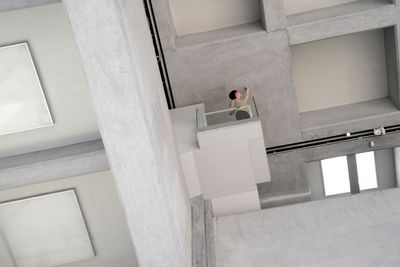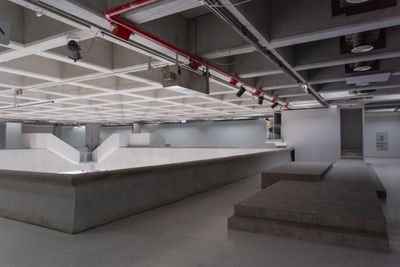Lai Chih-Sheng's Sight Lines at Taipei Fine Arts Museum
A subtle intervention takes centre stage on the third floor of the Taipei Fine Arts Museum, where Lai Chih-Sheng's latest project, Closer (25 June 2020–6 June 2021), consists of a site-specific installation that highlights the spatial characteristics of Space C.

Exhibition view: Lai Chih-Sheng, Closer, Taipei Fine Arts Museum, Taipei (25 June 2020–6 June 2021). Courtesy Taipei Fine Arts Museum.
Dedicated to experimental projects, Space C is designed to provide a panoramic view of the museum's grand lobby below. Lai makes use of this architecture in his construction: a series of runways whose lines of sight are complemented by two lookout points that jut out over the lobby, one of them high enough to allow viewers to reach up and touch the museum's ceiling.
These points make use of steel H-beams that connect with the museum's pillars, allowing them to be suspended over the museum's lobby. Comprising a net load of 500 kilograms per square metre, this is a substantial structure that required substantial efforts to install.
Prior to Closer, Space C hosted Michael Lin's project 7/24 (15 June 2019–31 May 2020), which covered walls in geometric patterns utilising colours of three well-known convenience stores: 7-Eleven, represented by red, green, and orange; FamilyMart, represented by blue, green, and white; and Hi-Life, represented by red and white. Furnishing the space were tables with tatami mats and cushions, as well as a series of paper lanterns designed by Isamu Noguchi, creating a sense of domestic familiarity.
In contrast to Lin's colourful installation, Closer engages with the site's existing greyscale colour scheme, making use of materials such as wood, fibre, and board to blend in. The installation fits so seamlessly into the architecture of Space C, in fact, that viewers might not even notice it. But despite its bare, minimalist appearance, carpeted corridor floors encourage tactile engagement. The carpet, Lai suggests, provides people with a sense of security despite the dizzying heights at which they are placed from this structure.
The subtle interplay between precarity and stability defines Lai's work, which engages with the relationship between the body and space by emphasising a sensory experience of site. As a member of the conceptual art collective National Oxygen, Lai staged early interventions in abandoned buildings and structures around Taipei in the 1990s, including a factory in which he stacked 100 bricks up to the ceiling.
In later works, such as Canton Flower Bridge (2018), the artist created a wood panel supported by a steel frame, which was attached to surrounding walls by a series of steel cables. For Border (2013), first presented in the artist's 2013 solo exhibition Instant at IT Park in Taipei and later presented at the 2015 Lyon Biennale, Lai created a very narrow walkway along the walls of a small room, with spectators invited to edge through this narrow pass while observing materials discarded by exhibition installers strewn across the floor.
This interest in diverting an audience's attention to space and site speaks to Lai's intervention at Taipei Fine Arts Museum. When architect Kao Er-Pan submitted a winning pitch to design this building in 1978, he refused to follow classical Chinese architectural trends that were popular at that time, such as the National Dr. Sun Yat-Sen Memorial Hall, National Chiang Kai-shek Memorial Hall, or the Grand Hotel. Instead, Kao chose to submit a design with modernism, embedded with a spirit of art for art's sake. Closer invokes that spirit by creating the conditions to contemplate its presence.—[O]












































































































































































